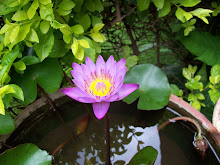 The Eranthemum nervosum, or Eranthemum pulchellum is a native Indian flower full of surprises. Its bright blue colour of the flower is very unusual in the tropics. And the plant flowers even in the summer. The dark green leaves look very striking in the shade. Once the flowers have finished blooming, the branches can be cut down to ground level, and the plant sends out more branches and flowers. Aphids and white flies are the plant's pests.
The Eranthemum nervosum, or Eranthemum pulchellum is a native Indian flower full of surprises. Its bright blue colour of the flower is very unusual in the tropics. And the plant flowers even in the summer. The dark green leaves look very striking in the shade. Once the flowers have finished blooming, the branches can be cut down to ground level, and the plant sends out more branches and flowers. Aphids and white flies are the plant's pests.This is a good plant to grow in dappled light in the tropics.







